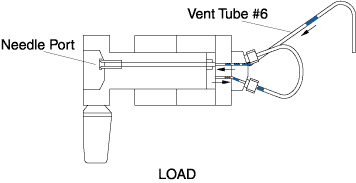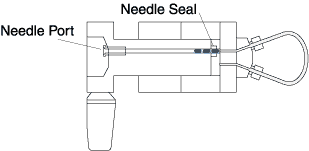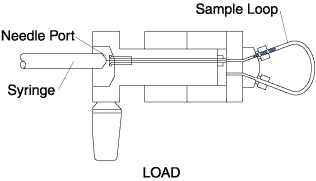 |
|||||||||

Comments
To
flush the needle port: Use from 0.1 to 1 mL of mobile phase. Use a Needle
Port Cleaner (Rheodyne Part Number 7125-054) attached to a luer tip
syringe. Flush only when the handle is in INJECT, so flow goes directly
out vent tube #5 and bypasses the loop. This cleans the entire length
of the needle port — guide, tube, and needle seal. The cleaner does
this because it seals against the front of the guide. A fully inserted
needle flushes none of these parts.
If you have no cleaner, use a luer tip syringe. See the illustration in Symptom #5. In routine operation, remove the syringe after turning to INJECT, but keep the handle in this position so the loop is continuously flushed with mobile phase. Flushing after every injection is rarely needed, but, if necessary, do it just before the next analysis. It is usually sufficient to flush after every ten or twenty injections. This keeps liquid in the needle port tube, which baths the syringe needle and dilutes contaminating sample. See Appendix E for more information on when to flush the injector.
There are non-injector sources of sample carryover. These include residual sample in the syringe, contamination in the blank solvent, and contamination in the solvent used for flushing.
Symptom #4
A miniature chromatogram of the previous sample is produced by injecting a blank. Flush the needle port (see comments). Load and inject a blank, using the loading method you have been using — partial-filling or complete-filling (see Fig. 15):
Fig. 15. Droplets of sample remaining in the needle port tube and needle seal. These are absent in normal operation.
Cause A
The needle port was contaminated with previous sample. It was pushed into the loop when the syringe was inserted during loading. The flushing step has cleaned the port (see Fig. 16).Solution
If the contamination reappears, make sure you are inserting the syringe properly. You may need to flush the needle port routinely. See Appendix E.
Fig. 16. When the syringe is inserted under the conditions shown in Fig. 15, droplets of previous sample are pushed into the loop.
Cause B
Excess sample from the previous injection was contained in vent tube #6. It siphoned into the loop prior to injection (see Fig. 17). If the vent tubes are not properly adjusted, this can occur when in LOAD and the syringe is not in the needle port.Solution
Adjust the vent tubes so they are level with the needle port (see Symptom #3). Keep the handle in the INJECT position until the next injection and flush just before returning to LOAD:
- If the peaks are still present after adjusting the vent tubes, investigate the possibility that the source of carryover is outside of the injector (see comments).

Fig. 17. Previous sample siphons from vent tube #6 into sample loop.
© 2000 Rheodyne All rights reserved

